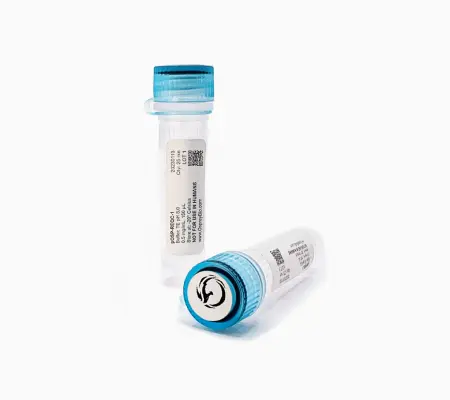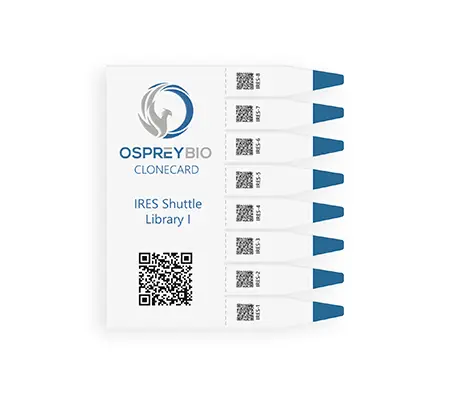Frequently Asked Questions
- Transcription Unit Library I CloneCard (pOSP-CCTU-1)
- IRES Shuttle Library I CloneCard (pOSP-CCIS-1)
- Reporter Vector Library I CloneCard (pOSP-CCRV-1)
This combo of CloneCards was designed to create a clear path for identifying, studying, and reporting on the optimal combination of components to insert into the cell.
Using the first 16 constructs from the two transcription unit libraries, along with your cell(s) and modality of choice, researchers can narrow down which transcription units best suit their research. Following this, the IRES shuttle library can quickly be screened within the cell(s) of interest, then used to test different orientations of ORFs in the cell. Finally, report your results with our library of reporter vectors designed to function within any lab operating at any funding level.
Perform an elution for each CloneCard tab you would like to use. After one hour, your elution buffer should have taken on a blue tinge and will contain the gene or construct listed on that CloneCard tab.
Each CloneCard contains eight constructs to encourage simultaneous exploration of multiple genes at once to maximize your lab's time and resources. Rather than following a single R&D path while targeting a gene of interest, diversify and strengthen your data by exploring interactions between different cell types, gene constructs, and multiple functions simultaneously . You may find that even constructs well-suited to your system are not the best functioning candidates when compared to your other options. This in-depth knowledge of how your system interacts with multiple constructs is key for gathering data for your next big discovery or building the best possible therapeutic candidate.
In short, no. OspreyBio includes eight vectors in each CloneCard to encourage multigenic research and the exploration of genes within a single system at a time in order to maximize your lab's time and resources. But don't worry - even eight of OspreyBio's vectors are comparable in price to just one vector from catalogues and/or DNS.
Even constructs confirmed through your research to be well-suited to your system may not be the best possible candidates when compared to other options, so trying several different constructs out in your cell(s) of interest may reveal unexpected data that takes your development process in a new direction. Even if your originally chosen construct proves to be the best possible construct for your cell(s) of interest, testing other options can give you key data on the nature of your therapy or even inspire your next discovery.
Multimodal therapies, also called combination therapies, utilize more than one modality of treatment such as messenger RNA, RNAi, gene therapy, and/or cell therapy.
Multi-effector therapies utilize more than one gene effector to treat a disease, targeting complex disease states that require the action of more than one therapeutic effector on different nodes of the disease.
Multigenic therapies target complex diseases by using more than one transcript which encodes for two or more open reading frames and/or two or more bioactive RNA molecules.
You can make therapies that are multimodal, multi-effector, and multigenic, or you can make therapies that fall under just one or two of these categories.
Please contact ospreylicensing@ospreybio.com if interested in developing a commercial product using Osprey's genes.



